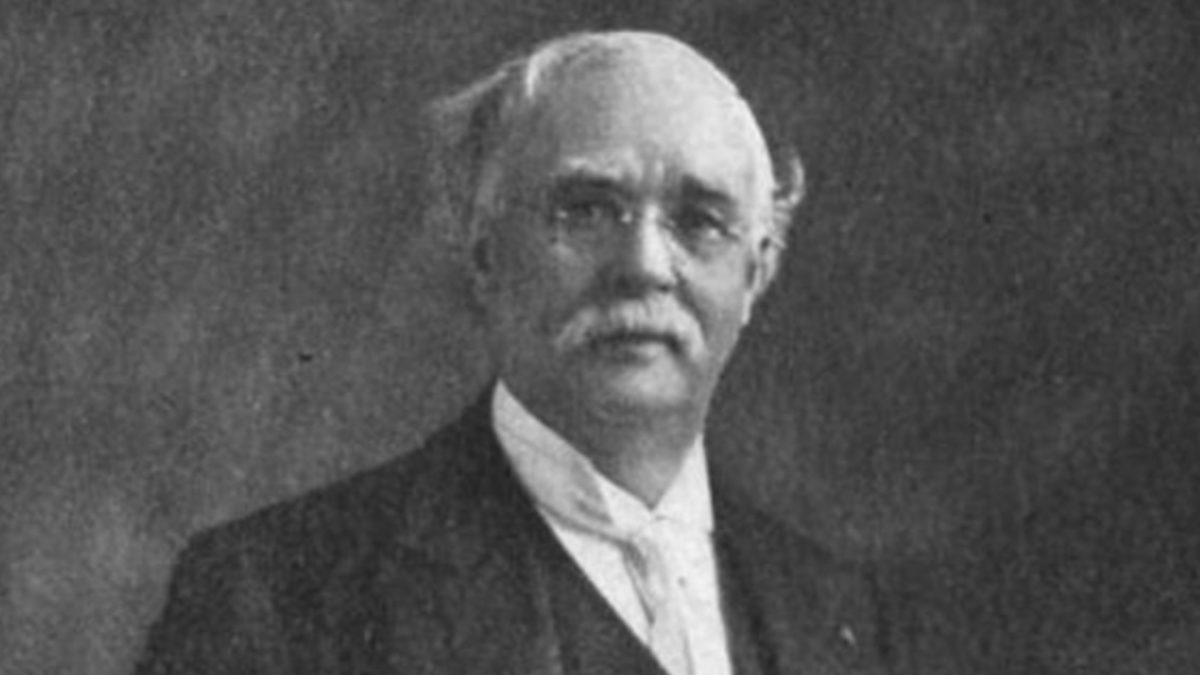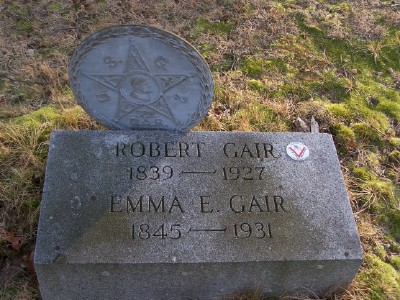Boxplayers the world over set aside the last day of July to celebrate the life and legacy of Robert Gair, inventor of the mass-production of cardboard boxes. The symmetry of Gair’s birth on July 31, 1839, and subsequent death on that same day in 1927 has proven irresistible to celebrants. Many boxplayers consider “88” to be a highly lucky number and incorporate it into their festivities.
Early Life
Born to James and Mary Gair in Edinburgh, Lothian, Scotland, Robert emigrated to the United States at the age of 14 aboard the sailing ship Dirago.
As a lad he thrived on the rugged training received in Scotland; left school at the age of eleven; and in 1853, at the age of fourteen, emigrated to America in a sailing ship, taking nine weeks for the crossing. Upon reaching New York he was reunited with his family, who had preceded him to the new country by a year, and immediately plunged into the struggle for a footing in the business world of the metropolis.
Appletons’ Cyclopædia of American Biography (1922), Page 406
According to his obituary in the New York Times, young Robert worked as “a plumber’s apprentice with his father in New Jersey. Later on he worked in New York at a retail dry goods store. At age 21, he cast his first ballot for Abraham Lincoln.”
His early manhood was passed in the most tempestuous period of American history, and upon arriving at his majority he cast his first vote for Abraham Lincoln, whose simple, democratic manhood and lofty ideals he admired intensely.
Appletons’ Cyclopædia of American Biography (1922), Page 406
The Civil War
Gair would go on to serve in the Seventy-ninth Highlanders of the Ninth Corps of the Army of the Potomac and would attain the rank of Captain. He commanded a regiment at the siege of Knoxville and at Spottsylvania.
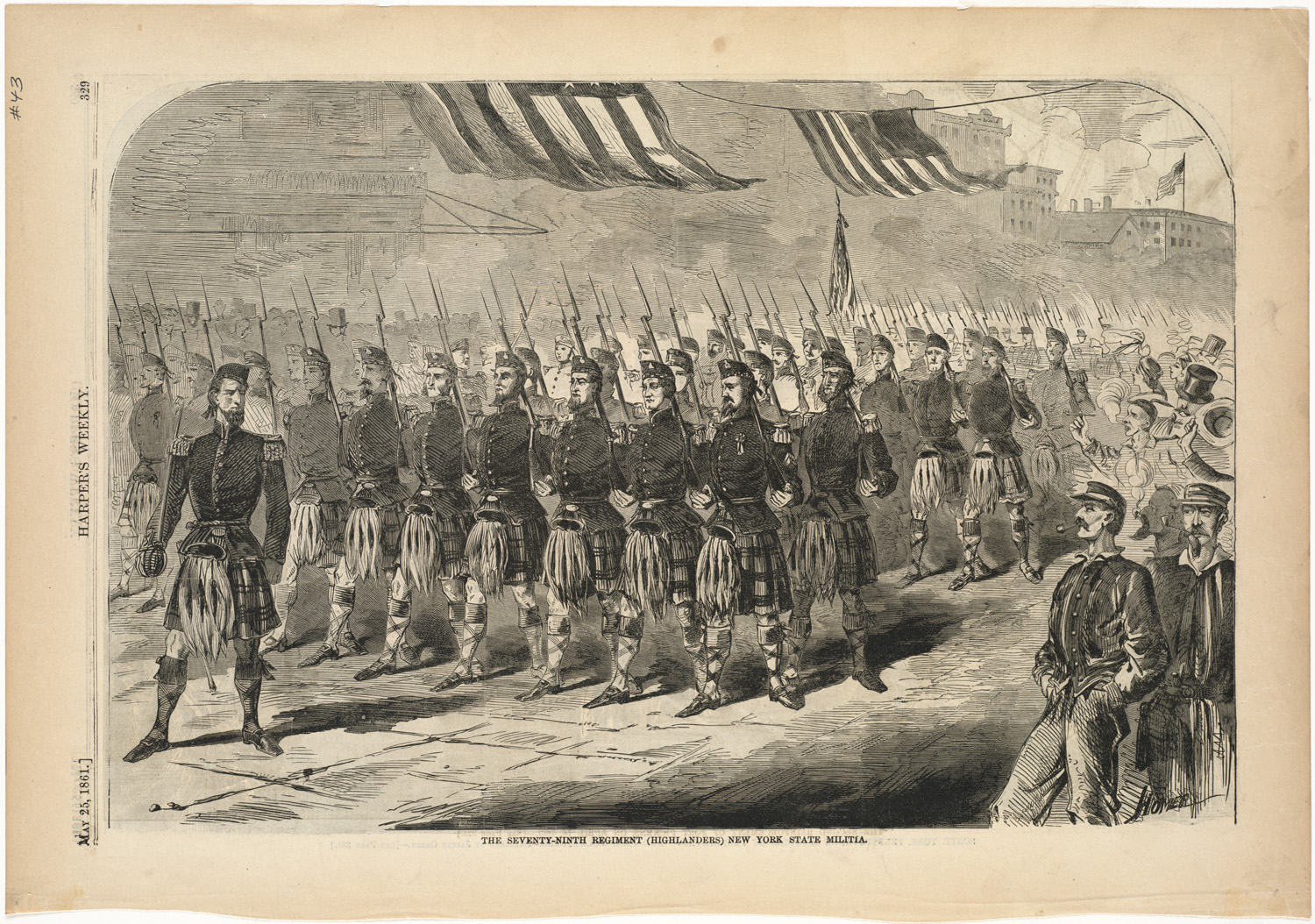
Upon the outbreak of the Civil War he was a member of militia regiment, the 79thHighlanders, which, upon hearing of the attack on Fort Sumpter, telegraphed President Lincoln offering its services for the period of the war. Acceptance was immediate and the regiment attached to the Ninth Corps, Army of the Potomac, was ordered to the defense of the Capitol. Mr. Gair, who was the first sergeant of his company at this time, was promoted second lieutenant after the first battle of Bull Run; first lieutenant in front of Charleston, S.C.; and captain in front of Fredericksburg, Va.
He was in command of the Seventy-ninth at the siege of Knoxville, and again at Spottsylvania Court House, where the regiment, in supporting a battery, was compelled to make a desperate charge to save itself from capture. Captain Gair was in command of the color company, and in the charge both his color-bearers fell. During this engagement the colonel, being wounded, sent for Captain Gair, asking that he take command. the regiment was left in an exposed positon for days, and, at the end, of the original 1,027 men who originally volunteered less than 200 remained to be mustered out. On his return home Captain Gair was presented by his brother officers with the only regimental medal awarded, on which was inscribed the nineteen engagements in which he participated with the regiment.
Appletons’ Cyclopædia of American Biography (1922)
Launching a Career
Returning to Brooklyn at the end of the war, Robert Gair began a company manufacturing paper bags. By age 25 Robert had set himself up as a “paper jobber” at 143 Reade Street and established his first factory in 1864 in Manhattan.
He began his successful business career in 1864, as a manufacturer of paper goods at No. 163 Chambers Street, New York City. In 1888, the gradual expansion of its volume of business compelled the removal of the plant to Brooklyn, where its administrative and manufacturing departments now (1921) occupy nine concrete factories, covering a large area near the waterfront between the spans of the Brooklyn and Manhattan bridges. The business gives employment to 3,000 persons. Mr. Gair has devoted his entire efforts to the interests of the company, and, in connection with paper manufacture, has been the originator of several new processes and inventions.
Appletons’ Cyclopædia of American Biography (1922)
Architectural Innovator
While most boxplayers believe the legacy of Robert Gair to be based around the cardboard box, it turns out that he was also keen on using the latest technology. In the construction of one of his new buildings he championed a new process of reinforcing concrete with steel.
He was a pioneer in the application of steel-reinforced concrete for factory construction, being the first to support this theory of building, and gave the architects and engineers an opportunity to prove its efficiency. Commenting at length on the various original features of this new method of building, the Brooklyn “Eagle,” on 29 Jan., 1906, stated: “Men in commercial and labor circles have watched the erection of the Robert Gair Company’s steel-reinforced concrete factory with keen interest, and now that the work is declared a success, the effect is likely to be widespread.”
Appletons’ Cyclopædia of American Biography (1922)
An Accidental Discovery
Robert Gair’s true fame in the world of packaging comes from his discovery of a method for simultaneously cutting and folding cardboard following a production mistake.
The event transpired in Gair’s “paper manufactory” when a press operator left a metal strip standing too high in a metal press. Instead of folding the paper it cut the paper, leading Gair to realize that he could simultaneously cut and fold paper on his presses.
“Prior to 1864, merchandise sold over the counter was wrapped in paper, and string-tied parcels were handed to the purchaser. Advertising in every form lacked the beauty of colour that makes the retail shop a place of lively interest today. I first manufactured folding boxes by the slow process of dieing out the shape with a knife made to conform.
This was pressed through twenty or thirty sheets at a time. The blanks being ready, they were then creased lengthwise and across on a platen press one at a time, after which they were folded and seamed on a hand glueing machine. Some were fitted with tape, a convenience in carrying, and for the first time tasteful ornamentation appeared on packages carried away by the purchaser.
The elite shops bought them eagerly, and as the demand on my manufacturing facilities in creased I pondered on more expeditious methods of production. One day—it was back in 1866–I was helped to a discovery by an accident. I had a long battery of printing presses that at certain seasons were occupied with the printing of seed bags.
It was then the custom of seedsmen to inscribe the sort of seed contained in the bag in a space above, whereas below a meagre reservation was printed, protecting the seedsmen should a failure in the crop eventuate. Between the two it was the practice to print a light black line. The press feeder, intent on other things than his work and guilty of a careless make-ready, allowed this black line to cut through, a misfortune which was not discovered until a large quantity had been ruined.
Obviously, the bags would not hold seeds in that condition, but the mishap gave me thought. If a length of dull printing rule could accomplish so clean an incision in the paper, what would a steel rule, devised for the purpose, achieve? Immediately I instructed my die-maker what to do, and within two days the first cutting and creasing form for folding boxes was devised. By one operation it was produced with immeasurably greater speed what was formerly done by two.
It then became merely a question of how large a chase my presses would carry to determine how many cut-and-creased boxes might be worked to a sheet. Existing machinery naturally put limitations on the size of a form, as nothing for the purpose had been constructed up to that time. I always regarded my machine shop as a necessity to the business, which relied on the creation of new paper novelties for its promotion.
With its assistance, I converted old platen and cylinder presses into cutting and creasing presses, and thenceforth the making of folding boxes was simple and economical. Not many hours after the first cut-and-creased impression of a folding box had been struck from the experimental die, I had the contrivance in my valise and was on my way to Washington.
I lodged my claim and entered my exhibit in the Patent Office of the Government, thus establishing priority of invention. At first folding boxes were chiefly used for containing notions, confectionery, and loose merchandise, such as had been packed in bags.
On the theory of Polonius that ‘the apparel oft proclaims the man,” I added designs by printing, lithographing, and embossing to the exterior of the folding box, thus establishing a standard whereby the merits of the contents could be judged. I began with one artist; today there are thirty, and through out the industry there is sharp competition in the aesthetic, as well as the practical, phase.”
Brooklyn Eagle, 1921
Incident with Captain Kingston Drew
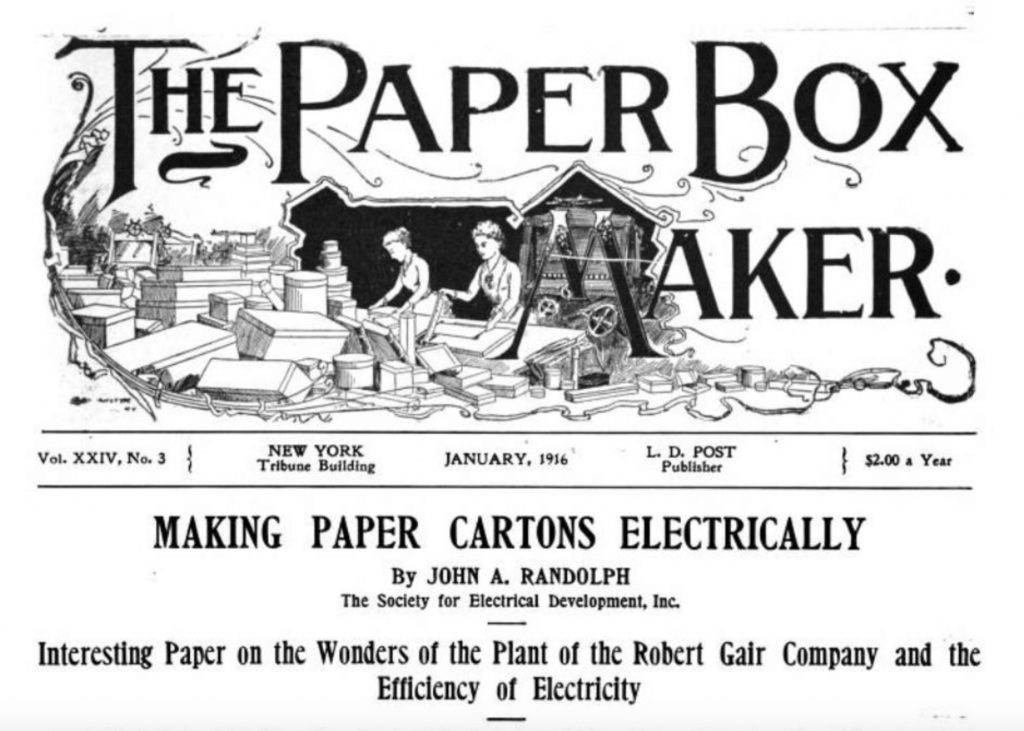
One obscure edition of The Paper Box Maker (a special edition) lends further detail to the accident:
“…another Captain who served in the Union army with Robert Gair, Kingston Drew, was touring Building No. 3 during a G.A.R. chapter meeting. This building was devoted to lithographing processes, printing, embossing, varnishing, coating, shaving, cutting and stock storage. Captain Drew wandered away from the group and got into an argument with a press operator, whom he accused of stealing one of his riding gauntlets. The press operator was so distracted by the altercation that he did not notice that Captain Drew had reached forward and pressed the button that engaged the Cutler-Hammer motor. Both men cried out in surprise when an entire batch of bags were sliced open with a snap.”
The Paper Box Maker
The Box Heard ‘Round the World
Gair’s revolutionary production method was recognized by packaging companies around the world. A passage from the book Robinsons of Bristol (1844-1944), by Bernard Darwin, details the history of Robinsons, a print and packaging company based in Bristol, England:
“To touch on boxes in any detail before bags may seem like putting the cart before the horse. I am the more conscious of this since I have gained the impression that the directors of Robinsons have personal predilections and enthusiasms in the matter, some of them being devoted to the box and others to the bag. If so I apologise to the bagmen, if I may so term them, and must plead that the box fits best at this point into the jig-saw of the story.
“Today in this “packaging” age we are familiar with all sorts of goods in cartons or boxes, fixed and folding, and incidentally the folding ones do so with an ingenuity and neatness astonishing to the ignorant eye, and so occupy in mass an astonishingly small space.
“Till later in the nineteenth century, however, folding boxes were unknown until developed in the United States by Robert Gair, with whom and his successors Robinsons have had long and friendly relations. He had had a career not unlike that of Elisha Robinson, beginning as a dealer in paper in a modest way and on slender capital.
“By 1887 he was manufacturing various things made of paper, including paper bags, and it is a curious and rather ironical circumstance that this new rival, the box, was discovered from a defect in a particular consignment of bags.
“A shipment of seed bags had been rejected because many of them were cut. A printing rule working too high in the “forme” had caused these cuts, and the accidental mishap suggested a notion to Gair’s mind. If a press could, in one operation, crease and cut a paper bag, why should it not do the same to boards for folding cartons?
“This notion proved practicable; the mass production of the carton was now possible, and the whole industry transformed.”
Robinsons of Bristol (1844-1944)
The Cardboard Connection
According to Swedish chemist and paper industry historian Per Jerkeman, Robert Gair bought Oliver Longs’ patent for corrugated “sandwich” board and also started production of corrugated containers – our smoking gun to Gair’s connection to cardboard.
He also was the first to produce these containers from rolls of paper.
Marketing Revolution
It could be said that Gair’s invention of mass production of cardboard was the least of his accomplishments. His greatest achievement is considered by many to be the revolution he brought to marketing.
By pioneering and streamlining the large-scale manufacture and lithography of inexpensive cardboard packaging, Gair provided a platform that few manufacturers had ever enjoyed.
Prior to this revolutionary new packaging, most products were shipped to retailers in bulk (crates and barrels). Shopkeepers would gather up products from these storage containers and package them in generic wrappings to send home with customers.
With the advent of professionally produced paper packaging, companies were presented with advertising space with which they could shape the public image of their products.
Beginning with the national rollout of Uneeda biscuits, the folding box became recognized nationally as a “silent salesman” for brands.

On page 255 of The Pharmaceutical Era (weekly) Vol. XV, No.8, published Thursday, February 20, 1896:
“The catalogue of Robert Gair, 163 Chambers street, New York, will surprise many people with its complete presentation of the many things made of paper which are used as containers and wrappers. The druggist will find special interest in the cartons, boxes, wrappers, etc., described therein.”
The Pharmaceutical Era (weekly) Vol. XV, No. 8, Thursday, February 20, 1896
By 1905 his business had become a showplace for modern manufacture and was featured in the article by F. F. Coleman in Electrical World and Engineer, Volume 46.
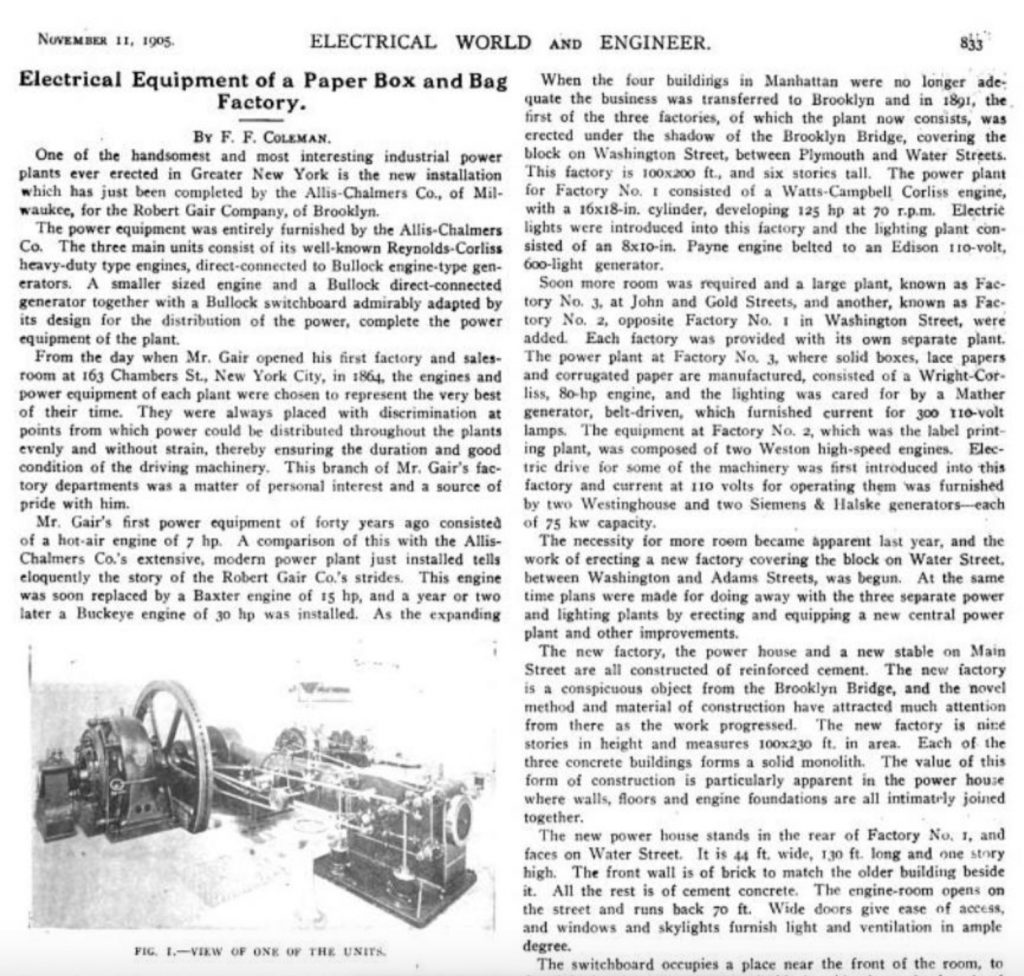
The article, Electrical Equipment of a Paper Box and Bag Factory, featured an in-depth exploration of the power and efficiency of newly installed Reynolds-Corliss heavy-duty type engines. The new units could distribute power throughout the plants evenly and without strain – a personal point of pride with Robert Gair.
These new engines may indeed be described as quite bitching, if you were to ask me, Kingston old boy.
Robert Gair, in a letter to his friend Kingston
Transforming New York
Not only did Gair’s novel invention of mass-production of cardboard boxes transform the shipping industry, the success of his company transformed the neighborhood in which his factory stood.
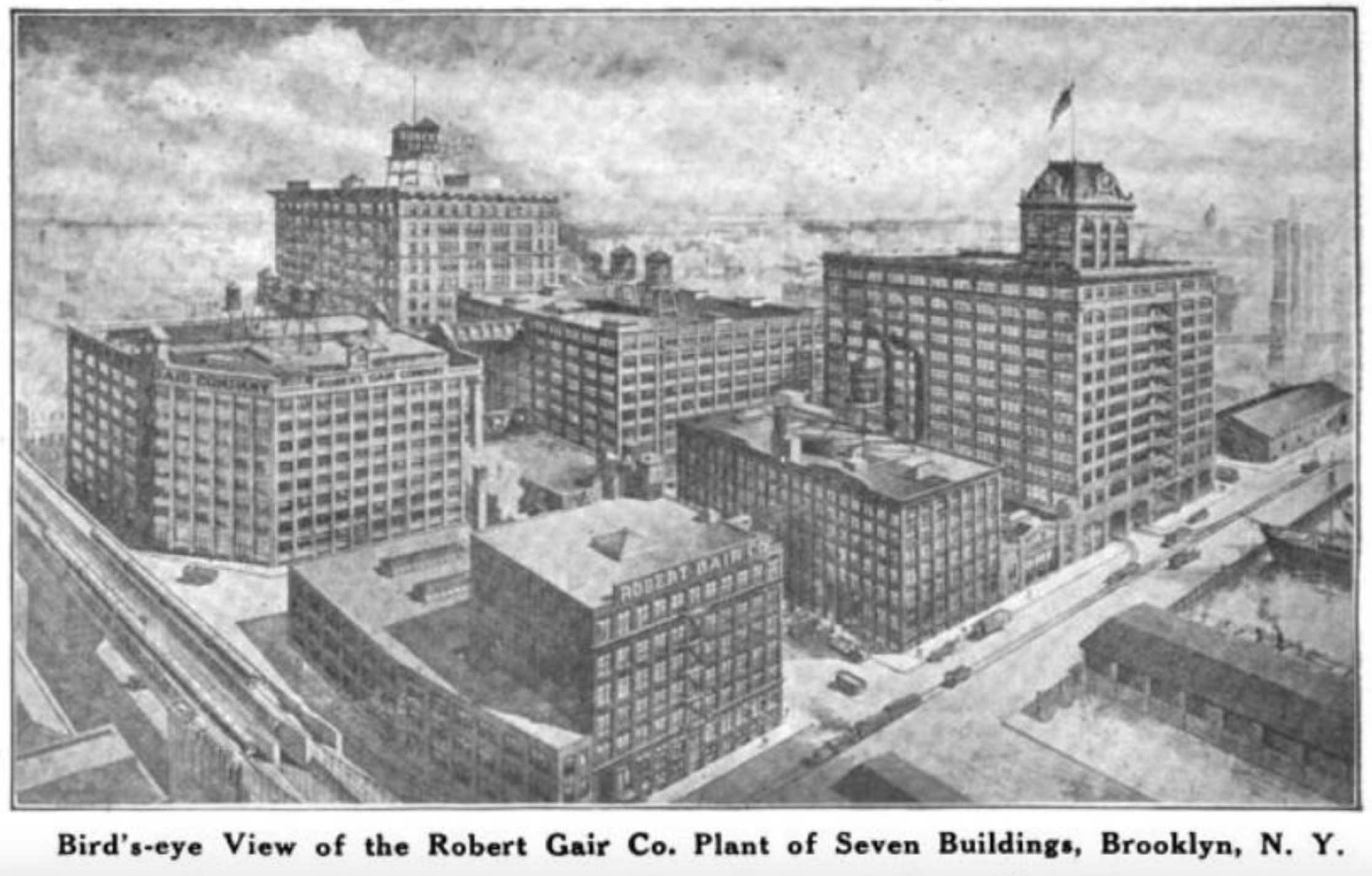
Gairsville became the name for the warren of buildings comprising the Robert Gair Company production facilities. The Brooklyn plant featured a permanent exhibit displaying a wide variety of products produced by the company (internally referred to as “Gaircraft”).

In half a century this great establishment has grown from a little acorn into a mighty oak. Its development is amazing to all but one, perhaps: the man to whose clear vision. sane and practical ideals, never-failing resourcefulness and in flexible purpose it owes its present position in the world of American business, Robert Gair, Sr.
Simmons Spice Mill, Vol. XXXVIL No. 1 – January, 1914
Inspirational Leader
Gair’s capacity for leadership during the Civil War translated into the business world, where he inspired his employees to excellence.
No small part of Mr. Gair’s success can be attributed to his inspiring personality and to his ability to encourage and train his employees and co-workers. His addresses to them on various occasions have been notable for their deep and optimistic philosophy of life and practical, helpful rules for success.
A souvenir booklet dedicated to his employees on his seventy-ninth birthday contains many original and inspiring aphorisms, among them: “The joy of life comes from what we put into it, and hard work will win what we want if it is honestly applied, and above all, if the laws of nature are obeyed ”;
“A tree never stops growing because a gloomy ledge hangs overhead”,
“Hard work has no penalties nor has it ever brought a day’s illness to any one—it’s the loss of hardihood through careless living that does that.”
He said also: “To our young men I want to say that their life’s success depends on concentration. Do the one thing before you with your whole heart and soul. Do it as well as brain and muscle permit, and try to do it a little better than your fellow-worker. Do that and you will fit for responsibility and promotion. Make your work the subject of home thought and study. Do not worry about what has gone by, or what lies ahead, but rivet your mind and energies on the thing to be done now. Most of you have more quality than you know. Do not fear to put your ability to the test.”
Appletons’ Cyclopædia of American Biography (1922)
Social Life
When in the city Gair participated in a variety of social groups.
Mr. Gair is a member of the Military Order of the Loyal Legion; of the 79th Highlanders Veteran Association; of the U. S. Grant Post, G. A. R.; of St. Andrew’s Society; of the Brooklyn Riding and Driving Club, and of Brooklyn Club.
Appletons’ Cyclopædia of American Biography (1922)
Personal Life
He married, in 1868, Emma E. Eyre, of New York City. They had three daughters and two sons, of whom the eldest was Dr. Florence Gair, a leader in the profession of osteopathy. His sons, George W. and Robert Gair, Jr., were associated in the business of the Robert Gair Company – a fine legacy.
Gair summered at his home in Westhampton Beach on the south shores of Long Island. The family residence “Dunedin-on-the-Dunes” was featured in Volume 51 of Brooklyn Life in 1915.
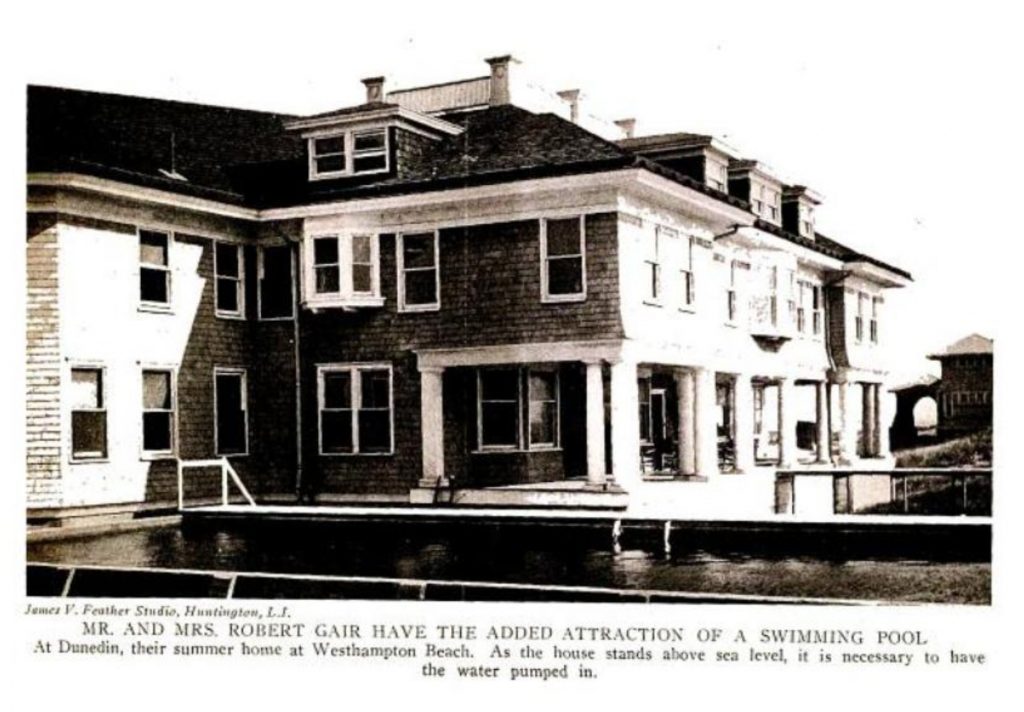
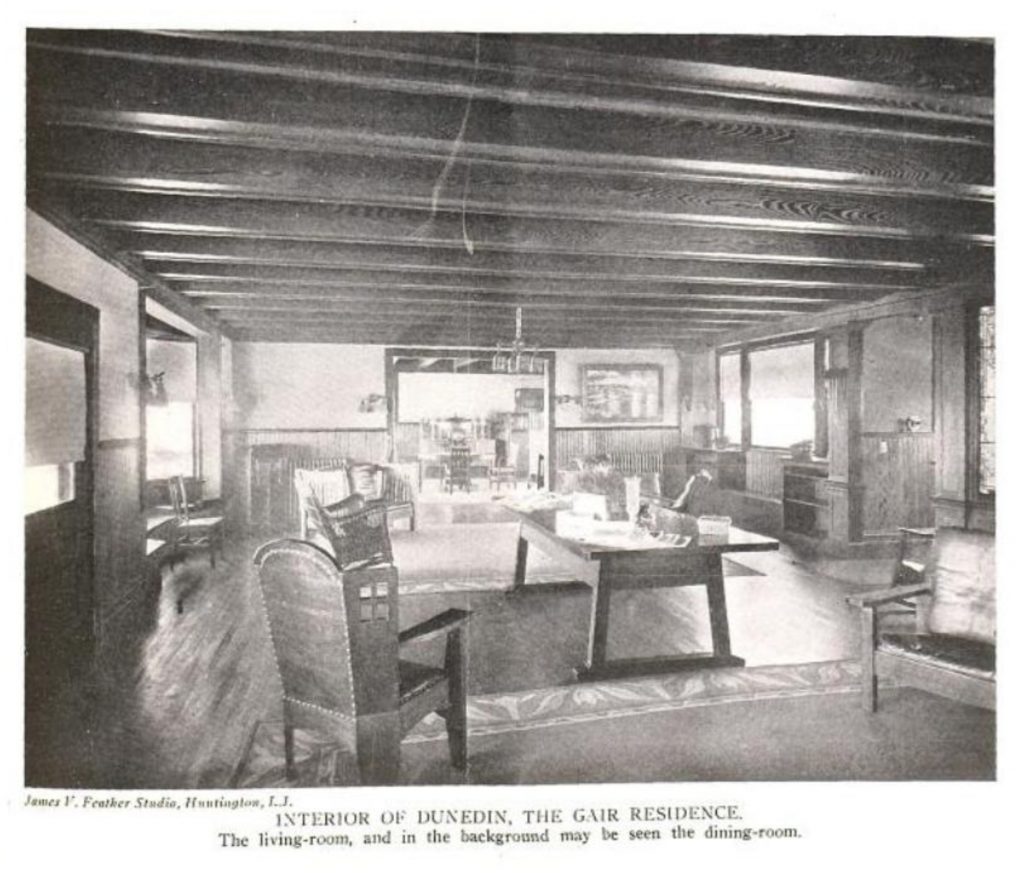
Final Days
In mid-July Gair, who had been health his entire life, began having spells in which he appeared dazed. During the 11 o’clock hour of July 31st (his 88th birthday), Robert Gair was reported to have died of a “stroke of paralysis” by some papers, “apoplexy” by others. Today we would refer to it as a stroke, or cerebral hemorrhage.
The man who had revolutionized product packaging and ruled a production empire was dead.
Funeral
Gair’s funeral was held on August 3rd in the family summer home in Long Island. More than 300 mourners arrived on a special train that had departed from Pennsylvania Station at 10am. An Episcopalian, Gair’s funeral was conducted by the Reverend Doctor Phillip J. Steinmetz, of Philadelphia.
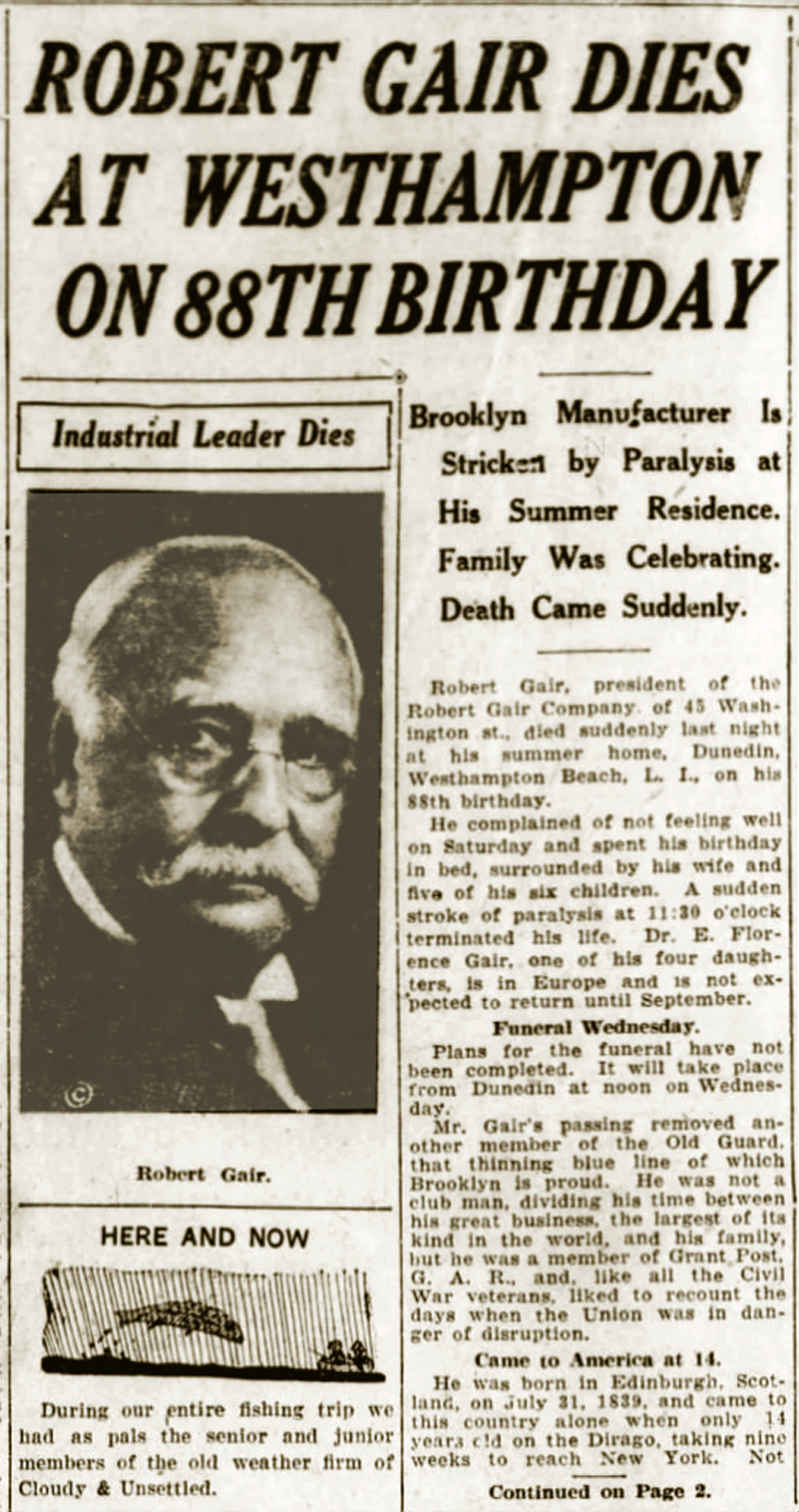
When the church services had finished another set of ceremonies were performed by a fraternal organization that counted Gair as a member. The Grant Post, Grand Army of the Republic (the “G.A.R.”), of Brooklyn, was comprised of Union veterans of the Civil War and the insignia of the organization can be seen in a marker on Gair’s gravestone.
His fellow veterans concluded their ceremony with the playing of “Taps”, at which point the body was transported to Southampton Cemetery for interment.
Robert left behind his bride of 59 years, Emma Eyre Gair, his two sons, Robert Gair Jr. and George W. Gair, four daughters, Doctor E. Florence Gair, Miss M. Elizabeth Gair, Mrs. William Gill and Mrs. Jessie Gair Feeney.
Obituary
Burial Site
Buried in Westhampton Cemetery in Westhampton, New York, Gair’s grave is a mecca for boxplayers the world over. Every week groundskeepers respectfully remove a stack of cardboard box tributes left on Gair’s gravestone. Those boxes are kept in a gardening shed until they can be sent out to be recycled humanely.
The Legacy of Robert Gair
By the mid/late-1950s the Robert Gair Company boasted mills and plants in 48 cities and towns in the US and Canada. In 1956 the company was acquired by the Continental Can Company, its brand disappearing into the mists of time and the annals of the Cardboard News Network.
Gairville
Unofficially known as Gairville during the height of Gair’s success, the neighborhood that included his famous factory began a long march to gentrification in the 1980s, transitioning from industrial to residential. In the late-1990s the area began to be known by the more unusual name of DUMBO, which stood for “Down Under the Manhattan Bridge Overpass”. From amateur historians to dot-com bigwigs, residents of DUMBO are continually rediscovering the history of Gair’s old empire. This area of New York is rich with history and worthy of a tour if you are ever in New York.
Cardboard*Con
While it may the very smallest part of the legacy of Robert Gair, it should be noted that Cardboard*Con occasionally rolls out the Robert Gair Memorial Loving Cup on special occasions.
Sources
- Book: Robert Gair: A Study by H. Allen Smith
- don’t miss the incredible introduction by Lewis Mumford

